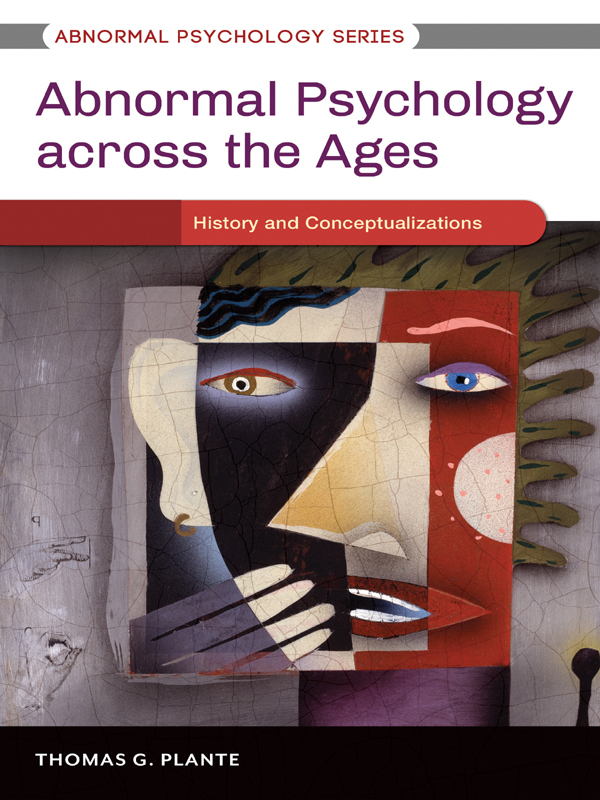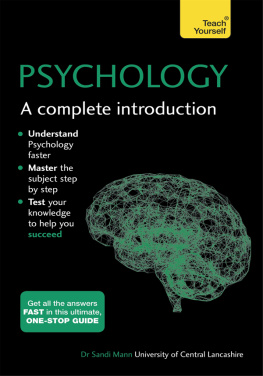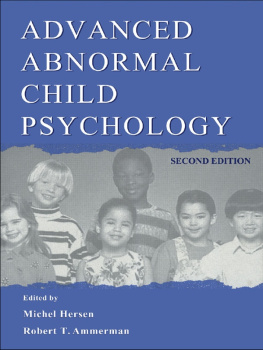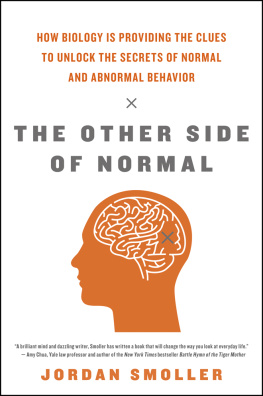
Abnormal Psychology across the Ages
Recent Titles in
Abnormal Psychology
Mental Disorders of the New Millennium, Volumes 13
Thomas G. Plante, Editor
Bleeding to Ease the Pain: Cutting, Self-Injury, and the Adolescent
Lori G. Plante
Understanding and Treating Depression: Ways to Find Hope and Help
Rudy Nydegger
The Praeger International Collection on Addictions, Volumes 14
Angela Browne-Miller, Editor
Sexual Abuse in the Catholic Church: A Decade of Crisis, 20022012
Thomas G. Plante and Kathleen L. McChesney, Editors
ABNORMAL PSYCHOLOGY ACROSS THE AGES
Volume 1
History and Conceptualizations
Thomas G. Plante, Editor
Praeger Perspectives
Abnormal Psychology
Thomas G. Plante, Series Editor

AN IMPRINT OF ABC-CLIO, LLC
Santa Barbara, California Denver, Colorado Oxford, England
Copyright 2013 by Thomas G. Plante
All rights reserved. No part of this publication may be reproduced, stored in a retrieval system, or transmitted, in any form or by any means, electronic, mechanical, photocopying, recording, or otherwise, except for the inclusion of brief quotations in a review, without prior permission in writing from the publisher.
Library of Congress Cataloging-in-Publication Data
Abnormal psychology across the ages / Thomas G. Plante, editor.
volumes cm. (Abnormal psychology)
Includes bibliographical references and index.
ISBN 978-0-313-39836-0 (hardback : acid-free paper) ISBN 978-0-313-39837-7 (Ebook)
1. Mental illnessHistory. 2. PsychiatryHistory. 3. Psychology, Pathological. I. Plante, Thomas G.
RC438.A238 2013
616.89dc23 2013001196
ISBN: 978-0-313-39836-0
EISBN: 978-0-313-39837-7
17 16 15 14 13 1 2 3 4 5
This book is also available on the World Wide Web as an eBook.
Visit www.abc-clio.com for details.
Praeger
An Imprint of ABC-CLIO, LLC
ABC-CLIO, LLC
130 Cremona Drive, P.O. Box 1911
Santa Barbara, California 93116-1911
This book is printed on acid-free paper 
Manufactured in the United States of America
For all those who have suffered with mental illness and for all those who have used their personal and professional gifts to ease their distress.
Contents
Preface
What is normal? What is abnormal? What is acceptable human behavior, and what is not? How do we understand why people do what they do, and what can we do to help those who behave in ways that are unhealthy, disturbing, and dangerous to themselves or to others? To attempt to answer these important questions, which often have had very different answers during various times in history, this book, Abnormal Psychology across the Ages, in three volumes, examines the past, present, and predicted future of our understanding and diverse perspectives regarding psychopathology and abnormal behavior, broadly defined. Leading experts from across multiple perspectives come together in this book to offer their views on abnormal psychology across the ages.
The first volume focuses on the history of abnormal behavior throughout time. This volume follows our understanding of abnormal behavior from ancient times through the Renaissance and Enlightenment eras, and through the 20th century. Additionally, this volume highlights different organizing principles and themes that have informed our views of psychopathology, such as biological, psychological, social, and cultural perspectives. The second volume provides a contemporary understanding of abnormal psychology in the present that reviews what we know about psychopathology from different diagnostic categories, such as eating disorders, mood disorders, cognitive disorders, and addictive disorders, to name just a few. The third volume examines current and future trends in abnormal psychology, such as the role of pharmaceuticals, legal issues, and global concerns.
In all, the reader is presented with thoughtful reflections and state-of-the art understandings of abnormal psychology across the ages from leading experts.
This book is a companion to various books on this topic published by Praeger/Greenwood/ABC-CLIO, most notably Mental Disorders of the New Millennium (Vols. I, II, and III), published in 2006.
Acknowledgments
Many people other than the author or editor assist in the completion of a book project. Some contribute in a direct way while others help in a more supportive manner. I would like to acknowledge the assistance of the people who worked to make the idea of this book a reality.
First and foremost, I would like to thank the contributors to this volume. They include some of the leading scholars in the field, who have worked like an all-star team to provide the reader with state-of-the-art reflection and scholarship. Second, it is important to recognize the wonderful people at ABC-CLIO who published this book. Most especially, many thanks go to my editor Debbie Carvalko for her many efforts not only with this book project but with many other book projects that I have published with her assistance during the past decade. Finally, I would like to thank my wife Lori and son Zach, who are daily reminders that life is good and sacred and that I am blessed beyond words to have them both in my life.
Chapter 1
Influences of the Greeks and Romans
Janet R. Matthews and Lee H. Matthews
Interest in abnormal behavior, or psychopathology, appears to have existed from the time of early written records. Our understanding of both the causes and treatment of behavior that differs from the typical has not been a steady movement of learning but rather has had periods of intense interest and writings followed by periods when prior knowledge seems to have been lost. The following chapter presents some of the highlights of this process from the perspective of the early Greek and Roman cultures. Brief information about some of the early people, myths, etiology, and treatments related to abnormal behavior is presented to illustrate the breadth of information they provided as a foundation that influenced thoughts about psychopathology for many centuries.
THE GREEKS
Personalities
For many scholars, the most influential Greek physician was Hippocrates of Cos (460377 B.C.). Because he believed that the brain was the central control of human activity, he felt that disrupted behavior was the result of brain pathology. Scientists of this era believed that the four basic elements of the world were earth, air, fire, and water. These elements had the attributes of heat, cold, moistness, and dryness. A combination of these attributes led to the development of bodily fluids known as humors. These bodily fluids were influenced by Hippocrates also believed that such environmental factors as air and water quality, altitude, and time of the year contributed to the development of these imbalances. He noted that abnormal behavior sometimes seems to impact more than one member of a family and thus suggested that heredity also plays a role in the development of psychopathology. Finally, Hippocrates hypothesized the presence of a life force that was psychological in nature. Although this force typically operated through the senses and motor system in a traditional biological fashion, when sleeping it could produce dreams that were important to understanding the persons problems. In order to have an adequate understanding of a persons psychopathology, Hippocrates noted the necessity of close behavioral observation of the patient.
Next page















